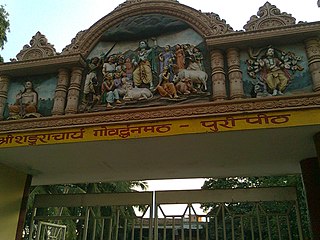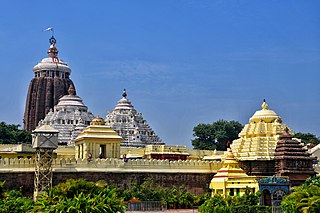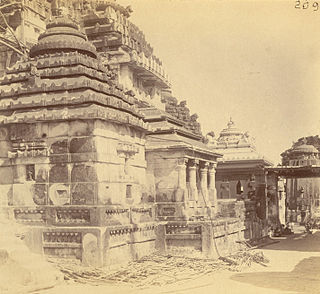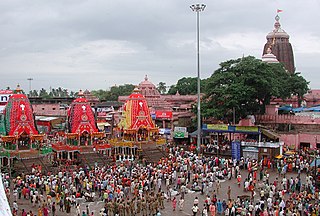The Jagannath Temple is a temple dedicated to the Hindu god Jagannath in Puri, Odisha, India.
Jagannath Temple may also refer to:

Jagannatha is a deity worshipped in regional Hindu traditions in India and Bangladesh as part of a triad along with his brother Balabhadra, and sister, Subhadra. Jagannath, within Odia Hinduism, is the supreme god, Purushottama, and the Para Brahman. To most Vaishnava Hindus, particularly the Krishnaites, Jagannath is an abstract representation of Krishna, or Vishnu, sometimes as the avatar of Krishna or Vishnu. To some Shaiva and Shakta Hindus, he is a symmetry-filled tantric form of Bhairava, a fierce manifestation of Shiva associated with annihilation.

Puri is a coastal city and a municipality in the state of Odisha in eastern India. It is the district headquarters of Puri district and is situated on the Bay of Bengal, 60 kilometres (37 mi) south of the state capital of Bhubaneswar. It is also known as Sri Jagannatha Dhama after the 12th-century Jagannath Temple located in the city. It is one of the original Char Dham pilgrimage sites for Hindus.

Rasgulla is a syrupy dessert popular in the eastern part of South Asia. It is made from ball-shaped dumplings of chhena dough, cooked in light sugar syrup. This is done until the syrup permeates the dumplings.

Purvamnaya Sri Govardhana Pitham or Govardhan Math is one amongst the four cardinal pithams established by the philosopher-saint Adi Shankara to preserve and propagate Hinduism and Advaita Vedanta, the doctrine of non-dualism. Located in Puri in Odisha, India, it is the Eastern Āmnāya Pītham amongst the five pithams, with the others being the Sringeri Śārada Pīṭhaṃ (Karnataka) in the South, Dvārakā Śāradā Pītham (Gujarat) in the West, Badari Jyotirmaṭha Pīṭhaṃ (Uttarakhand) in the North .It is associated with the Jagannath temple. Their Vedantic mantra or Mahavakya is Prajñānam brahma and as per the tradition initiated by Adi Shankara it holds authority over the Rigveda. The head of the matha is called Shankarayacharya, the title derives from Adi Shankara.

Puri district is a coastal district of the Odisha state of India. It has one sub-division, 11 tahasils and 11 blocks and comprises 1722 revenue villages. Puri is the only municipality of the district. Konark, Pipili and Nimapara are the three NACs in this district. Satyabadi, Gop, Kakatpur and Brahmagiri are major semi-urban areas.
The Odia (ଓଡ଼ିଆ), formerly spelled Oriya, are an Indo-Aryan ethnic group native to the Indian state of Odisha who speak the Odia language. They constitute a majority in the eastern coastal state, with significant minority populations existing in the neighboring states of Andhra Pradesh, Chhattisgarh, Jharkhand and West Bengal.
The birthplace of the twelfth-century Sanskrit poet Jayadeva, author of the Gitagovinda, has been disputed, with the neighboring states of Odisha, West Bengal in eastern India and the region of Mithila staking a claim. This had led to a bitter feud between people on both sides that lasted for over a century. The issue is still debated by scholars.

Anangabhima Deva III was an Eastern Ganga monarch who ruled an early medieval Odisha centered empire in eastern India from the year 1211 CE to 1238 CE. He was successful in maintaining a large extent of territory that stretched from the river Ganga in the north to Godavari in the South. He had successfully defeated the Kalachuris on the western frontiers of the empire and established a matrimonial alliance with them. His brother or brother in law, Rajaraja II became the ruler of the Dynasty in 1198. When Anangabhima III came into power, in 1211, he expelled the Muslims of Bengal from his kingdom. He had a son, Narasingha Deva I, who would later invade Bengal in 1244, and captured the capital city, Gauda. He was a reformist in the social and spiritual structure of the Odia society as the vaishnavite deity Jagannath was declared as the supreme ruler of the empire and the emperor as the deputy under him. The Madala Panji records he claiming himself as Shri Purushottama dedicating everything to lord Jagannath. He built the famous Pradaskhina mandapa of Srikurmam temple.
Gopalpur (Hindi/Bengali/Oriya) or Gopalapuram (Telugu/Tamil/Malayalam) may refer to:

Comilla Jagannath Temple, also known as Sateroratna Mandir or seventeen-jewel temple, is located in Comilla, Bangladesh. It is dedicated to the Hindu God Jagannath. It dates back to the early 18th century and was built by Ratna Manikya II, who was the king of Tripura. The deities of Jagannath, Balabhadra and Subhadra were originally installed in a temple in Tripura from where they were subsequently shifted to this temple.

The Char Dham, also rendered the Chatur Dhama is a set of four pilgrimage sites in India. Since the establishment of the Char Dham temples, visiting these sites has become a path to achieve moksha. The four Dhams are Badrinath, Dwarka, Jagannath and Rameswaram.

Patachitra or Pattachitra is a general term for traditional, cloth-based scroll painting, based in the eastern Indian states of Odisha, West Bengal and parts of Bangladesh. Patachitra artform is known for its intricate details as well as mythological narratives and folktales inscribed in it. Pattachitra is one of the ancient artworks of Odisha, originally created for ritual use and as souvenirs for pilgrims to Puri, as well as other temples in Odisha. Patachitras are a component of an ancient Bengali narrative art, originally serving as a visual device during the performance of a song.
Odia diaspora are people of Odia ancestry residing outside the Indian state of Odisha.

Raj-Ranpur is a small town in the district of Nayagarh in the eastern Indian state of Odisha. The village is also known as Ranpurgarh or simply Ranpur as per the modern usage. The village is historically significant especially during the British Raj when it was the capital of the princely state of Ranpur. The martyrs Shaheed Raghu-Dibakar who were hanged for their resistance to British rule belong to this place. Rajsunakhala and Tang-Chandapur are the nearest Town of Raj- Ranpur, which in almost 14 & 10 km from the village. Rajsunakhala is the most important business Town in Ranpur block under Nayagarh district.

The Vimala Temple or Bimala Temple is a Hindu temple dedicated to goddess Vimala or Bimala (ବିମଳା), located within the Jagannath Temple complex in Puri in the Indian state of Odisha. It is generally regarded as a Shakti Pitha, among the holiest temples dedicated to the Hindu Goddess.
Puri Jagannath may refer to:

Deula is an architectural element in a Hindu temple in the Kalinga architecture style of the Odishan temples in Eastern India. Sometimes the whole temple is also referred to as Deula. The word "deula" in Odia language means a building structure built with a particular style that is seen in most of the temples from Odisha. Deul is also used in English, though the deul temples are also of a different form in the Manbhum region of Western Bengal.

Ratha Yatra, or Chariot festival, is any public procession in a chariot. They are held annually during festivals in India, Nepal and Sri Lanka. The term also refers to the popular annual Ratha Yatra of Puri. that involve a public procession with a chariot with deities Jagannath, Balabhadra, Subhadra and Sudarshana Chakra on a ratha, a wooden deula-shaped chariot.
New Jagannath Sadak - The road to Jagannath Dham, Puri :

The Bhoi dynasty or the Yaduvamsa dynasty were a medieval Hindu dynasty from the Indian subcontinent, which originated in the region of Odisha that reigned from 1541 to 1560 CE. Govinda Vidyadhara had usurped the throne from the later weaker Suryavamsa Gajapati Empire rulers as the kingdom started weakening but had a short-lived reign as ruling chiefs of Odisha as the ensuing internal rivalries and constant threats of invasions rendered them weak and were eventually overthrown by Mukunda Deva of Chalukya dynasty in 1560.